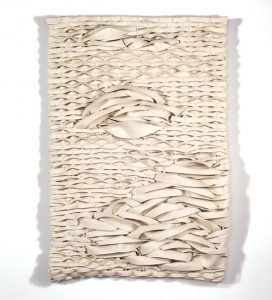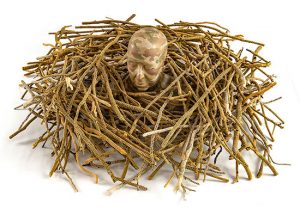What a month! April was quite the month for us here at browngrotta arts as we hosted our once-a-year Art in the Barn exhibition art + identity: an international view. The exhibition was a great success and we are so thankful for all the support near and far. At the beginning of April, we shared pieces by Neha Puri Dhir and Paul Furneaux, both of whom are new to browngrotta arts. Dhir’s piece Zazen caught the eye of many on social media, becoming our most liked “New This Week” post to date. In recent years, Dhir has experimented with the meticulous and labor-intensive techniques of shibori (bandhini India and adire in Nigeria. In doing so, Dhir sources all of her fabric from places all across India. As visible in Transition Dhir’s design influenced by the Japanese wabi-sabi aesthetic, which is centered on the acceptance of impermanence and imperfection.

Japanese woodcuts on wood , 19.5” x 40” x 4”, 2015. Photo by Tom Grotta.
Like Dhir, Scottish artist Paul Furneaux also draws inspiration from a Japanese aesthetic. Furneaux’s works, City Trees II and City Lights II, which grace the cover of our art + identity: an international view catalog, were made using the traditional Japanese woodblock printing technique known as mokuhanga. In making his City Trees and City Lights series, Furneaux wanted to try out chunkier forms with wider surfaces. “I was aware that the interaction between the two forms was important,” explains Furneaux “once I had established this relationship with the wooden form, I became very interested in how the clothing of the form made the forms spatial interaction more complex.”
Premiering in April were also works by Nnenna Okore and Brigitte Bouquin Sellés. In works like Coulée les de fils, Brigitte Bouquin Sellès uses selvedge ends, produced during the manufacture of the well-known Cholet handkerchief on looms in France. These strips are cut automatically by the machine from the outer edges of the weave. The artist reinterprets this manufactured material, made up of falls destined for destruction. The mutation is profound, these falling fabrics become works that are born by gravity. Using this material, the creation mode of Brigitte Bouquin Sellès is original: it creates not by adding material but not subtraction either, in this case, small pieces of weft still attached to the warp, snatched one by one to achieve the artist’s ends.
To wrap up April, we shared Norma Minkowitz’ The Path. The piece is very personal for Minkowitz, in creating it she explored her thoughts, identity and how she feels about the path her life is taking. Minkowitz even used a casting of her own head for the center of the piece, painting it with a camouflage pattern to camouflage her feelings and fears, a process you can see in this video.
If you weren’t able to make it to the exhibition, have no fear, you can still see the pieces featured in our coveted exhibition catalog art + identity: an international view, which is available for purchase in our online store HERE.



